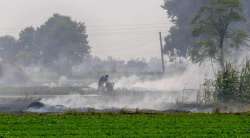Health Minister Satyendar Jain links COVID-19 deaths in Delhi to pollution by stubble burning
After the national capital saw more than a 100 Covid-19 deaths for four consecutive days, Delhi Health Minister Satyendar Jain on Monda attributed the high COVID-19 death rate in the city to the pollution caused by stubble-burning and expected a downtrend in it in the next two-three weeks.

After the national capital saw more than a 100 Covid-19 deaths for four consecutive days, Delhi Health Minister Satyendar Jain on Monda attributed the high COVID-19 death rate in the city to the pollution caused by stubble-burning and expected a downtrend in it in the next two-three weeks.
Delhi recorded 4,454 fresh COVID-19 cases on Monday and a positivity rate of 11.94 per cent while 121 more fatalities pushed the death toll to 8,512. The highest single-day spike till date here -- 8,593 cases -- was recorded on November 11 when 85 fatalities were recorded.
As many as 121 fatalities were recorded on Monday. This is the sixth time in the last 12 days that the daily number of deaths has crossed the 100-mark in Delhi. Authorities reported 121 deaths on Sunday, 111 on Saturday, 118 on Friday,131 on November 18, the highest till date, and 104 fatalities on November 12.
ALSO READ | Delhi: Over 100 deaths for fourth day in a row, November toll 1,950
The minister while speaking to mediapersons said that the pollution due to stubble-burning caused problems in breathing and those who had Covid-19 inhaled the smoke, which aggravated the seriousness.
He said that its effect on the city's COVID-19 death rate will go away in the next two-three weeks since pollution due to stubble-burning has lessened in the last few days.
"There was heavy pollution due to stubble-burning amid the COVID-19 pandemic and it came as a double attack. Since the pollution due to stubble burning is less now, the downtrend in deaths will be there in a few weeks," Jain said.
Delhi recorded 6,746 fresh COVID-19 cases on Sunday and a positivity rate of 12. 29 per cent, while 121 more fatalities pushed the city's death toll due to the disease to 8,391, authorities said.
Experts attribute the high figure of daily COVID-19 deaths in the national capital to a large number of "critical" non-resident patients coming to the city for treatment, an unfavourable weather, pollution and a better "reporting and mapping" of fatalities. They say the easing of restrictions has exposed the vulnerable population, such as the elderly and those having comorbidities, to the deadly virus.
Jain, however, assured that there was a downward trend in the number of cases and case positivity rate — number of samples that test positive among total tested — suggesting that the situation is likely to improve in the city.
"Since November 7, when the positivity rate was more than 15 per cent, it has come down to over 12 per cent now. The number of fresh cases was over 8,500 on November 10, which reduced to 6,746 on Sunday," he said.
(With PTI inputs)
ALSO READ | Will prepare policies to control stubble burning, curb air pollution in Delhi-NCR: Air quality panel